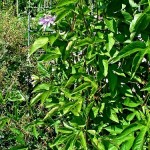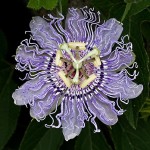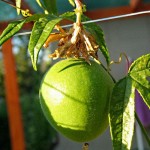Maypop-Passion Flower – Passiflora incarnata
|
Current Demand = Normal |
Parts Used: Herb |
 |
 |
 |
 |
Family: Passifloraceae
Common Names: Maypop, Passion Flower, Wild Apricot, May Apple, Maracuja, passionflower, carkifelek, charkhi felek, maypop passionflower, granadilla, passionvine, maracoc, apricot-vine…
Description:
This herbaceous vine has trilobed leaves, long trendils, cream to lavender flowers with long violet filaments, and yellow-skinned fruits. The fleshy fruit is also called a Maypop, is an oval yellowish berry about the size of a hen egg. It is first green, then becomes orange as it matures. It is a fast growing perennial vine that uses trendils to grab hold of adjacent shrubs to support itself to heights of 8-12 feet. It is native to southeastern United States and is often seen growing on the edges of the fields, along ditches and other sunny moist and fertile places. The buds of the flowers begin to bloom in July and continue until frost, open one by one and start at the oldest part of the vine.
Planting/Cultivation:
Growing region: the passion flower can be found thru-out the Midwestern United States, from Pennsylvania south to Florida and west to Oklahoma and Texas. It is often found in fence rows and tree lines where sandy soil exists and the plant is allowed to climb.
The May-pop likes the full to part sun and light evenly moist soil. Maypop may be propagated by softwood cuttings of fully mature wood in early summer. Cuttings will take 3 months or longer to root. It can also be grown from seed. The seeds must be soaked in warm water for 12 hours before sowing indoors, in the early spring. Germination may take up to one year. Keep young plants indoors until spring and transplant into permanent homes. The roots like a loose mulch.
Harvesting/Drying:
Parts Used: herb
For maximum potency passion flower should be harvested in the mid to late summer months while the plant is in bloom. When gathering passion flower, only harvest the parts above the ground not the root. Cut the vine off at ground level to allow the rot system to stay in tact for future growth. Gather the larger more mature plants leaving plenty of younger smaller plants to seed the area for future harvest.
For drying purposes and to preserve the green color gather passion flower in the afternoon once the morning dew has dried. Farmers and land owners often consider Passion Flower to be a nuisance plant and should be glad to allow you access to all of the passion flower growing on their property.
After harvest, remove all foreign matter (rocks, weeds and vines) and spread in a thin layer immediately. Passion flower has a large fruit which grows in abundance on the vine. Before you start the drying process these fruits will have to be either removed or smashed to allow drying. Passion flower fruit/seed pods if left whole will mold and could possibly ruin your entire harvest.
Passion flower herb can be dried outdoors though it needs to be dried out of the sun. At night cover you passion flower to keep the dew from setting on the drying herb. When possible dry indoors in a well ventilated barn loft or attic to protect from the elements. If natural heat is not available, you may need to add heat to a room and a fan for continuous airflow. Whether you are drying indoors or outside you will need to turn or stir the herb daily. The key to drying any root, herb or bark is an even combination of heat and airflow. Never dry in an oven or microwave.
The passion flower will completely dry (largest stem will snap not bend and leaves will crumble) in 3-7 days depending on drying conditions. Once the drying is complete, place the vines carefully into a cardboard box or burlap bag for storage in a dry area until ready to sell or use. Do not store the vines in plastic or it will mold.
Attributes (Images)
By H. Zell (Own work) [GFDL or CC BY-SA 3.0], via Wikimedia Commons
By {{{Photo by: Oliver P. Quillia}}} (Own work) [CC BY 3.0], via Wikimedia Commons
 Root Buyer
Root Buyer